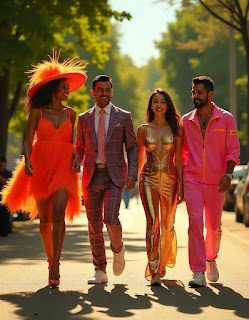Street Style Fashion
Road Style Design: A Combination of Solace and Individuality
Road style design has developed into a powerful social peculiarity that rises above conventional design standards. It's not restricted to runways or shiny magazines; all things being equal, it's brought up in the city by people who express their special characters through attire. In this article, we'll dig into the underlying foundations of road style, its advancement, and the effect it has on the design scene.
Beginnings of Road Style
Road style design arose naturally from metropolitan conditions during the twentieth hundred years. At first, it was a resistance to the formal, frequently prohibitive, style of the time. Youth subcultures like the Teddy Young men in the UK and the Hipsters in the US made ready for a more relaxed and expressive way to deal with dressing.
During the 1970s, the troublemaker development further energized the ascent of road style, described by whimsical and Do-It-Yourself clothing. Self locking pins, tore pants, and calfskin coats became famous images of this insubordinate design time. The roads turned into a material for self-articulation, testing cultural standards through clothing.
Development Over Decades
As we moved into the 1980s and 1990s, road style kept on developing, affected by music sorts like hip-bounce and grit. Loose jeans, larger than average hoodies, and striking embellishments became staples of the streetwear stylish. Brands like Adidas and Nike, at first active apparel goliaths, acquired fame in metropolitan design scenes.
The 2000s saw the ascent of streetwear names like Preeminent and BAPE, obscuring the lines among high and low style. Restricted version deliveries and coordinated efforts with specialists or big names added an elite appeal to streetwear. Shoes turned into a point of convergence, progressing from athletic wear to an image of status and style.
During the 2010s, virtual entertainment stages like Instagram assumed a vital part in democratizing style. Road style forces to be reckoned with and design bloggers acquired conspicuousness, displaying their unmistakable outfits to a worldwide crowd. This obvious a shift from conventional style specialists to a more equitable, publicly supported way to deal with stylish.
Road style is described by its varied blend of impacts, making a mixture of design variety. A few key components characterize this kind:
1. Individuality: At its center, road style is tied in with communicating one's singularity. There's no need with focus on complying to mold manages yet about breaking them and making a one of a kind assertion.
2. Mixing High and Low Fashion: Road style easily mixes very good quality planner pieces with secondhand shop finds. It's not necessary to focus on the brand yet about how the pieces are styled together.
3. Comfort is Key: Not normal for conventional design that frequently focuses on feel over solace, road style embraces both. Agreeable shoes, larger than usual outlines, and breathable textures are normal components.
4. Accessorizing: Embellishments assume a significant part in road style. Whether it's assertion shades, thick gems, or a particular pack, frill add to the general look.
5. DIY and One of a kind Finds: Road style fans frequently integrate DIY components and rare pieces into their outfits, adding a hint of credibility and sentimentality.
Worldwide Effect and Influence
What was once a subculture has now turned into a worldwide peculiarity impacting standard style. Road style patterns from urban communities like Tokyo, London, and New York are analyzed and duplicated around the world. Style a long time in these urban communities feature very good quality fashioner assortments as well as give a stage to road style fans to show their fashion imagination.
The impact of road style is obvious in the manner very good quality design brands team up with streetwear names and component road style stars in their missions. The limit among extravagance and streetwear has become progressively obscured, with high style embracing components from the roads as well as the other way around.
Manageability in Road Style
Lately, there has been a developing accentuation on manageable and moral design inside the road style local area. One of a kind shopping, upcycling, and supporting eco-accommodating brands are becoming necessary to the ethos of road style. This shift mirrors a more extensive consciousness of the natural effect of quick style and a longing to make a more practical design industry.
Challenges and Criticisms
While road style is praised for its inclusivity and inventiveness, it isn't without analysis. Some contend that the commodification of road culture by top of the line brands dissolves its legitimacy. Moreover, allegations of social allotment emerge when certain styles are co-picked without a comprehension of their social importance.
The Eventual fate of Road Style
As we look forward, the fate of road style appears to be encouraging. The democratization of design through virtual entertainment, the accentuation on manageability, and the nonstop mixing of high and low design demonstrate that road style will stay a unique power in forming the style scene.
All in all, road style design is a strong type of self-articulation that has developed from a grassroots development to a worldwide peculiarity. Its foundations in resistance and distinction have prepared for a design scene that praises variety, imagination, and solace. As road style proceeds to impact and be affected by standard design, it stays a lively and steadily developing social power.





Comments
Post a Comment